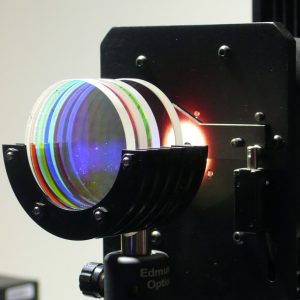While most gonio-photometric measurements at CC Building Skin cover wide spectral ranges such as visible or near-infrared light, some applications require a spectrally resolved measurement of light scattering. The combination of optical filters in the light path allows to select lower and upper boundaries of the effective wavelength band in the measurement according to the characteristic of the sample, and the required resolution. Since the detector only receives the fraction of incident power that is within a given, narrowed wavelength band, and in the directional range covered by the sensitive area of about 10mm x 10mm, such measurements on surfaces with low reflectivity are a particular challenge.
To test the limits of spectrally resolved BSDF measurements employing the gonio-photometer’s configuration, a diffuse sample with a nominal direct-hemispherical reflection of only 2% was taken as a “worst-case scenario” and characterized in the wavelength range 400nm to 450nm. A previous spectrometric measurement employing an integrating sphere resulted in an average reflection of 1.5% in this wavelength band (with a reported uncertainty of 15%), while the integral of the light scatter recorded by the gonio-photometer was computed as 2%.

